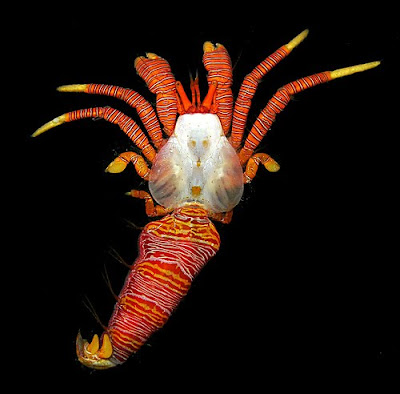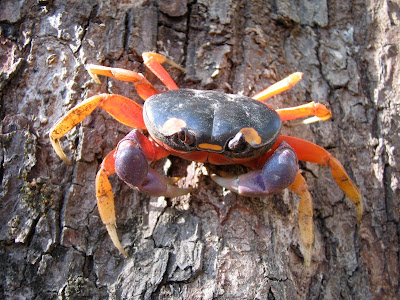Crabs are decapod crustaceans of the infraorder Brachyura, which typically have a very short projecting “tail” (Greek: βραχύ/brachy = short, ουρά/οura = tail), or where the reduced abdomen is entirely hidden under the thorax. They are generally covered with a thick exoskeleton, and armed with a single pair of chelae (claws). 6,793 species are known. Crabs are found in all of the world’s oceans. Additionally, there are also many freshwater and terrestrial crabs, particularly in tropical regions. Crabs vary in size from the pea crab, only a few millimetres wide, to the Japanese spider crab, with a leg span of up to 4 m.
1. Leucosia anatum
This is certainly a pretty crab with bright colorations and intricate markings. This species of crab is named
scientifically as Leucosia anatum.
2. Harlequin Crab (Lissocarcinus orbicularis)
This beautiful crab with awesome pattern is commonly known as Harlequin Crab or Lissocarcinus orbicularis.
3. Sally Lightfoot Crab (Grapsus grapsus)
This brightly colored crab is also commonly known as Red Rock Crab and Abuete Negro. It is one of the most
common crabs along the western coast of South America
Young Grapus grapsus are black or dark brown in color and camouflage well on the black lava coasts of volcanic
islands. Adults are quite variable in color. Some are muted brownish-red, some mottled or spotted brown, pink, yellow,
orange or red stripes or spots blue and green ventrally, and sporting red claws and pink or blue eyes.
4. Halloween Hermit Crab (Ciliopagurus tricolor)

This awesomely and uniquely colored crustacean is a Halloween Hermit Crab or Ciliopagurus tricolor. It is extracted
from its cone shell to show its bright coloration. It is found in Mayotte, Indian Ocean
5. Ghost Crabs (Ocypode quadrata)
Will you consider this crab a ghost? Well, it doesn’t look scary at all. For me, it looks adorable. Ghost crabs, also
called sand crabs, are common shore crabs in many countries. It is called ghosts because of its ability to disappear
from sight almost instantly, scuttling at speeds up to 10 mph, while making sharp directional changes.
6. Coconut Crab (Birgus latro)
This unique and colorful crab is called Coconut Crab, the world’s largest land-living arthropod. It is known for
its ability to crack coconuts with its strong pincers in order to eat the contents.
This crab is also called the Robber Crab or Palm Thief, because some coconut crabs are rumored to steal shiny
items such as pots and silverware from houses and tents. Another name is Terrestrial Hermit Crab, due to the use
of shells. The coconut crab also has a range of local names; in Guam it is known as Ayuyu and in Cook Islands it
is Unga or Kaveu.
7. Halloween Crab (Gecarcinus quadrates)
A Halloween Crab is also known as the Moon Crab, Mouthless Crab or Harlequin Land Crab. It is a colorful crab
found in mangrove sand dunes and rainforest along the Pacific coast from Mexico south to Peru. It is a nocturnal
crab that digs burrows as long as 1.5 m or 5 ft. It lives in the forest at least some of its adult life, but needs to return
to the ocean to breed. It has gills that need to be moist all the time. If not, they die and have a life span of 10-15 years.
8. Chilean Centolla (Lithodes santolla)
This large and brightly colored crab species is also known as the Southern King Crab. It is found off the
Pacific coasts of South America. It lives in the benthic zone at depths up to 150 m to 600 m.
9. Lemon-yellow Clawed Fiddler (Uca perplexa)
Yellow flowers are beautiful and so with yellow crabs. This yellow colored species is also sometimes known
as a Calling Crab. It is found along sea beaches and brackish inter-tidal mud flats, lagoons and swamps. If this
crab has lost legs or claws, a new one will be present when they molt.
10. Dungeness Crab (Cancer magister)
The Dungeness crab is a species that inhabits eelgrass beds and water bottoms from the Aleutians Islands
in Alaska to California. Its binomial name simply means “master crab” in Latin. It is a popular delicacy, and is
the most commercially important crab in the Pacific Northwest.
11. Rainbow Crab (Cardisoma armatum)
Rainbow Crab, as its name implies, is definitely one of the most beautifully colored species of crab. It originated
in Africa’ western coastal areas but it also occurs inland along some deltas and on Cape Verde.
This crab has a bluish/violet carapace, red-colored legs, and whitish claws when it is young. This coloration
usually fades as the animal grows older. While juvenile and adult crabs spend most of their time on dry land,
the females must return to the ocean to release their eggs. If the young do not make landfall by the time they are
fully developed they will drown.
12. Bermuda Land Crab (Gecarcinus lateralis)
This colorful crab is also known by several common names like Blackback Land Crab, Bermuda Land Crab and
Red Land. While it is a land crab and adults mainly occur in burrows in fields, marshes, mangroves and sandy
beaches, they need to return to the ocean to breed and its gills need to be moist all the time, or it will die.
13. Christmas Island Red Crab (Gecarcoidea natalis)
This pretty Christmas Island Red Crab is a terrestrial crab found in Christmas Island in the Indian Ocean.
Although restricted to a relatively small area, it is estimated that up to 120 million red crabs may live there,
making it the most abundant of the 14 terrestrial crab species on Christmas Island.
14. Blue Crab (Callinectes sapidus)
The Blue Crab’s binomial name simply means “beautiful swimmer” and “savory”. It is found in the waters
of the western Atlantic Ocean and Gulf of Mexico. It is the State Crustacean of Maryland and the subject of an
extensive fishery. They can deliver an extremely painful pinch and are noted for being particularly aggressive
and difficult to handle safely.
Blue crabs are blue because their shell contains a number of pigments, including Alpha-crustacyanin, which
interacts with a red pigment, astaxanthin, to form a greenish-blue coloration.
15. Purple Rock Crab (Leptograpsus variegates)
This handsome-looking crab, Purple Rock Crab, is a marine large-eyed crab found in southern subtropical
Indo-Pacific. It grows to around 50 mm shell width.
This nocturnal crab is capable of remaining out of water for days, but can also stay submerged. A fast runner,
it can be very aggressive with its nippers.
16. Common Rock Crab (Hemigrapsus sexdentatus)
Crab’s color when cooked is usually red. The Common Rock Crab is always red even if it’s alive. It is a marine
large-eyed crab native to the sea coasts of New Zealand. Coloration is a reddish purple, mottled with dirty white
patches, with pale green antennules with dark red spots. Rock Crabs are known to feed on snails by crushing
their shells that’s why they are regarded as “the meanest organisms”.
17. Blue Porcelain Crab
This species of crab is one of the most beautiful and colorful crabs. Commonly known as Blue Porcelain Crab,
it is reef safe and harmless and makes a great addition for the beginner to the advanced aquarist.
18. Porcelain Anemone Crab
Porcelain crabs are not true crabs although they superficially resemble true crabs. Only a specialist would know
that it is not a true crab. They live in all the world’s oceans, except the Arctic Ocean and the Antarctic.









I thought You could be interested in this article : Pet Dog and Viper Cars
.jpg)











it's a beautiful crab
ReplyDeleteyou are a robber...this is my article and it is originally posted here...you have no shame
ReplyDeletehttp://www.bukisa.com/articles/50745_the-worlds-most-colorful-crabs